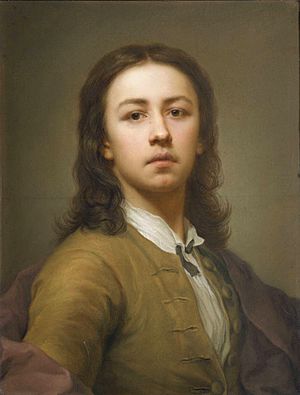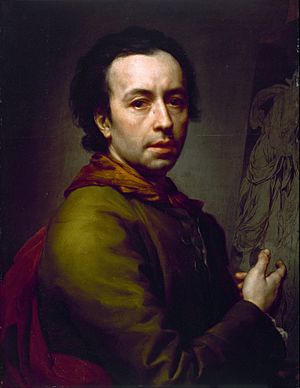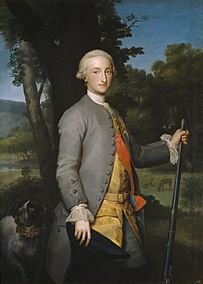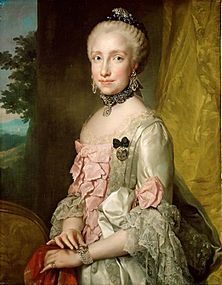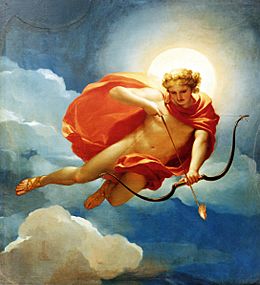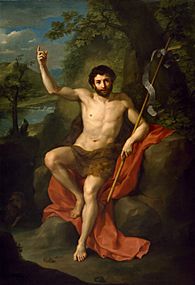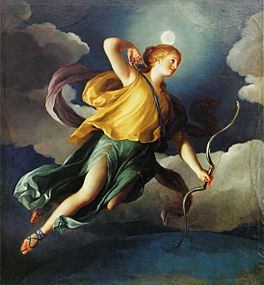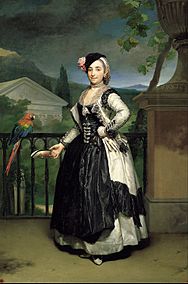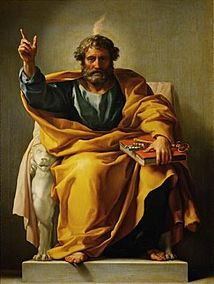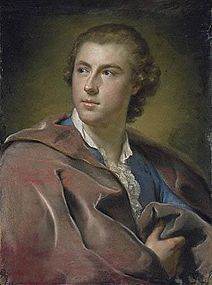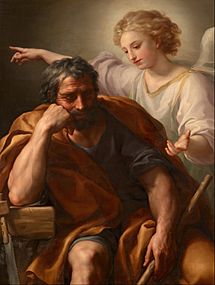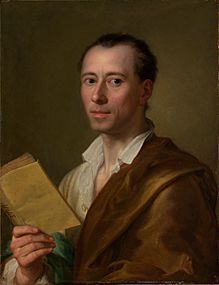Anton Raphael Mengs facts for kids
Quick facts for kids
Anton Raphael Mengs
|
|
|---|---|

|
|
| Born | 12 March 1728 |
| Died | 29 June 1779 (aged 51) |
| Nationality | German |
| Occupation | Painter |
| Movement | Neoclassical |
| Spouse(s) | Margarita Guazzi (m. 1748) |
| Children | Anna Maria Mengs |
| Relatives | Therese Mengs (sister) Julia Charlotte Mengs (sister) |
Anton Raphael Mengs (born March 12, 1728 – died June 29, 1779) was an important German painter. He worked in cities like Dresden, Rome, and Madrid. Mengs lived during the Rococo art period. However, his painting style helped start a new art movement called Neoclassicism. This new style soon became very popular in Europe.
Contents
Early Life of Anton Raphael Mengs
Anton Raphael Mengs was born in 1728 in Ústí nad Labem. This town is in a region once known as the Kingdom of Bohemia. His father, Ismael Mengs, was also a painter from Denmark. Ismael later settled in Dresden, which was an important center for art. Anton's older sister, Therese Maron, and younger sister, Julia, were also painters.
Anton's birth in Bohemia was due to his parents' travels. His father, Ismael, often took his family on trips. Anton was born during one of these journeys. A few weeks after Anton's birth, his father brought him and his mother back to Dresden. They lived there for the next 13 years. In 1741, the Mengs family moved from Dresden to Rome.
Adulthood and Important Works
In 1749, Anton Raphael Mengs became the main painter for Frederick Augustus. He was the ruler of Saxony. Even with this important job, Mengs spent a lot of time in Rome. In Rome, he married Margarita Guazzi in 1748. She had been a model for his paintings. He also became a Catholic.
In 1754, Mengs became the director of the Vatican painting school. This was a very respected position. His large wall painting (fresco) called Parnassus at Villa Albani made him famous. People saw him as a master painter.
Around 1749, Mengs was asked by the Duke of Northumberland to copy a famous painting. He made a full-sized oil copy of Raphael's fresco The School of Athens. This copy is now in the Victoria and Albert Museum in London.
Mengs passed away in Rome in June 1779. He was buried in the Church of Santi Michele e Magno.
Mengs's Career and Style
Mengs was invited twice by Charles III of Spain to work in Madrid. There, he created some of his best art. One famous work is the ceiling of the banqueting hall in the Royal Palace of Madrid. This painting shows the Triumph of Trajan and the Temple of Glory.
After finishing this work in 1777, Mengs went back to Rome. He died two years later. He had many children, and the King of Spain helped support seven of them. Mengs's portraits and self-portraits are known for their great detail. They often show a deep understanding of the person.
Mengs was a friend of Johann Joachim Winckelmann, a famous art historian. Mengs shared Winckelmann's love for ancient Greek and Roman art. He worked to make Neoclassical painting more popular than the Rococo style. However, his religious paintings still showed some influence from the older Baroque art style.
Mengs had a friendly competition with another Italian painter, Pompeo Batoni. He was also friends with Giacomo Casanova. Casanova wrote about Mengs in his famous book, Histoire de ma vie. Some of Mengs's students included Anton von Maron and Agustín Esteve.
Besides his many paintings in Madrid, other important works include:
- Ascension and St Joseph in Dresden.
- Perseus and Andromeda in Saint Petersburg.
- The ceiling of the Villa Albani.
- A painting called Noli me tangere at the National Gallery, London.
- Another altar-piece at Magdalen College, Oxford.
Mengs's Ideas About Art
Mengs wrote books about art in Spanish, Italian, and German. He believed that perfect art could be made by combining the best parts of different styles. He thought artists should use Greek design, the emotional expression of Raphael, the light and shadow (chiaroscuro) of Antonio da Correggio, and the colors of Titian.
Selected Works
- Ascension (Dresden, Court Church), 1751/1766
- St Joseph (Dresden, Court Church), 1751/1766
- The Glory of Saint Eusebius (ceiling fresco, Sant'Eusebio, Rome), 1757
- Portrait of Ferdinand I (National Museum of Capodimonte, Naples, Italy), 1759
- Charles III (Museo del Prado, Madrid), 1761
- Infante Don Louis de Borbon (Cleveland Museum of Art, Cleveland, Ohio)
Gallery
-
Prince of Asturias, Future Charles IV of Spain (са. 1765)
-
Portrait of Maria Luisa of Spain
-
Helios as Personification of Midday (ca. 1765)
-
St. John the Baptist Preaching in the Wilderness
-
Diana as Personification of the Night (ca. 1765)
-
Portrait of William Burton Conyngham (1733–1796)
-
Johann Joachim Winckelmann (1717–1768) (1717–1768) at the Metropolitan Museum of Art (ca. 1777)
Images for kids
-
Anton Raphael Mengs' grave in Rome
See also
 In Spanish: Anton Raphael Mengs para niños
In Spanish: Anton Raphael Mengs para niños
- Karl Woermann, Ismael und Raphael Mengs (Leipzig, 1893)


